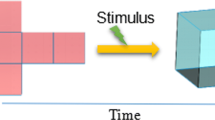Abstract
Three dimensional printing has gained considerable interest lately due to the proliferation of inexpensive devices as well as open source software that drive those devices. Public interest is often followed by media coverage that tends to sensationalize technology. Based on popular articles, the public may create the impression that 3D printing is the Holy Grail; we are going to print everything as one piece, traditional manufacturing is at the brink of collapse, and exotic applications, such as cloning a human body by 3D bio-printing, are just around the corner. The purpose of this paper is to paint a more realistic picture by identifying ten challenges that clearly illustrate the limitations of this technology, which makes it just as vulnerable as anything else that had been touted before as the next game changer.















Similar content being viewed by others
References
Gardan N, Schneider A (2014) Topological optimization of internal patterns and support in additive manufacturing. J Manuf Syst. doi:10.1016/j.jmsy.2014.07.003
Galantucci LM, Lavecchia F, Percoco G (2008) Study of compression properties of topologically optimized FDM made structured parts. CIRP Ann Manuf Technol 57(1):243–246. doi:10.1016/j.cirp.2008.03.009
Gibson I, Rosen DW, Stucker B (2010) Additive manufacturing technologies. Springer, New York. doi:10.1007/978-1-4419-1120-9
Chu J, Engelbrecht S, Graf G, Rosen D (2010) A comparison of synthesis methods for cellular structures with application to additive manufacturing. Rapid Prototyp J 16(4):275–283. doi:10.1108/13552541011049298
Vayre B, Vignat F, Villeneuve F (2012) Designing for additive manufacturing. Procedia CIRP 3:632–637. doi:10.1016/j.procir.2012.07.108
Rezaie R, Badrossamay M, Ghaie A, Moosavi H (2013) Topology optimization for fused deposition modeling process. Procedia CIRP 6:521–526. doi:10.1016/j.procir.2013.03.098
Mellor S, Hao L, Zhang D (2014) Additive manufacturing: a framework for implementation. Int J Prod Econ 149:194–201. doi:10.1016/j.ijpe.2013.07.008
Lipson H, Moon F, Hai J, Paventi C (2005) 3D printing the history of mechanisms. J Mech Des 127(5):1029–1033. doi:10.1115/1.1902999
Calì J, Calian D, Amati C, Kleinberger R, Steed A, Kautz J, Weyrich T (2012) 3D-printing of non-assembly, articulated models. ACM Trans Graph TOG 31(6):130. doi:10.1145/2366145.2366149
Navangul G, Paul R, Anand S (2013) Error minimization in layered manufacturing parts by stereolithography file modification using a vertex translation algorithm. J Manuf Sci Eng 135(3):031006. doi:10.1115/1.4024035
Ahn D, Kim H, Lee S (2007) Fabrication direction optimization to minimize post-machining in layered manufacturing. Int J Mach Tools Manuf 47(3):593–606. doi:10.1016/j.ijmachtools.2006.05.004
Kulkarni P, Marsan A, Dutta D (2000) A review of process planning techniques in layered manufacturing. Rapid Prototyp J 6(1):18–35. doi:10.1108/13552540010309859
Finishing processes: bond, seal and beautify 3D printed parts. http://www.stratasys.com/solutions-applications/finishing-processes
Brajlih T, Valentan B, Balic J, Drstvensek I (2011) Speed and accuracy evaluation of additive manufacturing machines. Rapid Prototyp J 17(1):64–75. doi:10.1108/13552541111098644
Pandey PM, Venkata Reddy N, Dhande SG (2003) Real time adaptive slicing for fused deposition modelling. Int J Mach Tools Manuf 43(1):61–71. doi:10.1016/S0890-6955(02)00164-5
Hiller J, Lipson H (2009) Design and analysis of digital materials for physical 3D voxel printing. Rapid Prototyp J 15(2):137–149. doi:10.1108/13552540910943441
Kai CC, Fai L, Chu-Sing L (2003) Rapid prototyping: principles and applications in manufacturing. World Scientific Publishing Co., Inc, Singapore
Chen Y, Zhou C, Lao J (2011) A layerless additive manufacturing process based on CNC accumulation. Rapid Prototyp J 17(3):218–227. doi:10.1108/13552541111124806
Keating S, Oxman N (2013) Compound fabrication: a multi-functional robotic platform for digital design and fabrication. Robotics Comput-Integr Manuf 29(6):439–448. doi:10.1016/j.rcim.2013.05.001
Song X, Pan Y, Chen Y (2015) Development of a low-cost parallel kinematic machine for multidirectional additive manufacturing. J Manuf Sci Eng 137(2):021005. doi:10.1115/1.4028897
Tong K (2003) Amine Lehtihet E.; Joshi, S.: parametric error modeling and software error compensation for rapid prototyping. Rapid Prototyp J 9(5):301–313. doi:10.1108/13552540310502202
Liu W, Li L, Kochhar AK (1998) A method for assessing geometrical errors in layered manufacturing. Part 1: error interaction and transfer mechanisms. Int J Adv Manuf Technol 14(9):637–643. doi:10.1007/BF01192283
Shin K-H, Natu H, Dutta D, Mazumder J (2003) A method for the design and fabrication of heterogeneous objects. Mater Des 24(5):339–353. doi:10.1016/S0261-3069(03)00060-8
Kou XY, Tan ST (2007) Heterogeneous object modeling: a review. Comput Aided Des 39(4):284–301. doi:10.1016/j.cad.2006.12.007
Dutta D, Prinz FB, Rosen DW, Weiss LE (2001) Layered manufacturing: current status and future trends. J Comput Inf Sci Eng 1(1):60–71. doi:10.1115/1.1355029
Compton B, Lewis J (2014) 3D-printing of lightweight cellular composites. Adv Mater 26(34):5930–5935. doi:10.1002/adma.201401804
Christ S, Christ S, Schnabel M, Vorndran E, Groll J, Gbureck U (2015) Fiber reinforcement during 3D printing. Mater Lett 139:165–168. doi:10.1016/j.matlet.2014.10.065
Pham DT, Gault RS (1998) A comparison of rapid prototyping technologies. Int J Mach Tools Manuf 38(10–11):1257–1287. doi:10.1016/S0890-6955(97)00137-5
Pandey PM, Venkata Reddy N, Dhande SG (2007) Part deposition orientation studies in layered manufacturing. J Mater Process Technol 185(1):125–131. doi:10.1016/j.jmatprotec.2006.03.120
Ma W, But W-C, He P (2004) NURBS-based adaptive slicing for efficient rapid prototyping. Comput Aided Des 36(13):1309–1325. doi:10.1016/j.cad.2004.02.001
Pandey PM (2003) Venkata Reddy, N.; Dhande, S. G.: slicing procedures in layered manufacturing: a review. Rapid Prototyp J 9(5):274–288. doi:10.1108/13552540310502185
Phatak AM, Pande SS (2012) Optimum part orientation in rapid prototyping using genetic algorithm. J Manuf Syst 31(4):395–402. doi:10.1016/j.jmsy.2012.07.001
Sun SH, Chiang HW, Lee MI (2007) Adaptive direct slicing of a commercial CAD model for use in rapid prototyping. Int J Adv Manuf Technol 34(7–8):689–701. doi:10.1007/s00170-006-0651-y
Campbell I, Combrinck J, de Beer D, Barnard L (2008) Stereolithography build time estimation based on volumetric calculations. Rapid Prototyp J 14(5):271–279. doi:10.1108/13552540810907938
Roberson DA, Espalin D, Wicker RB (2013) 3D printer selection: a decision-making evaluation and ranking model. Virtual Phys Prototyp 8(3):201–212. doi:10.1080/17452759.2013.830939
Piegl LA (2005) Ten challenges in Computer-Aided Design. Comput Aided Des 37(4):461–470. doi:10.1016/j.cad.2004.08.012
Author information
Authors and Affiliations
Corresponding author
Rights and permissions
About this article
Cite this article
Oropallo, W., Piegl, L.A. Ten challenges in 3D printing. Engineering with Computers 32, 135–148 (2016). https://doi.org/10.1007/s00366-015-0407-0
Received:
Accepted:
Published:
Issue Date:
DOI: https://doi.org/10.1007/s00366-015-0407-0




